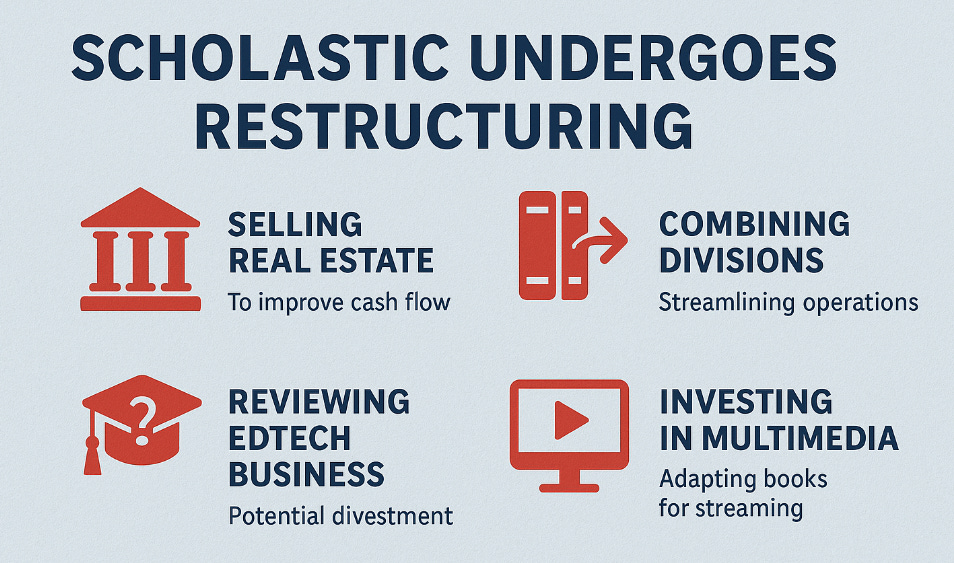Scholastic’s Big Restructuring: How the Children’s Publishing Giant is Fighting to Stay Relevant
Adapting to Falling Sales, Digital Competition, and a Changing Marketplace to Secure the Future of Children's Publishing
Scholastic Corporation, one of the world’s most recognized children’s publishers, is now undergoing major restructuring. The company is responding to declining sales, changing reader habits, and a significant drop in its stock price.
In the past year, Scholastic’s stock fell roughly 40% (Wall Street Journal). Sales have slowed, particularly in the U.S. school market, where tight budgets and new digital options have changed the way children access stories. At the same time, kids are spending far more time on YouTube and streaming services, drawing attention away from books.
Why Scholastic is Restructuring
Scholastic is famous for school book fairs and brands like Harry Potter, Dog Man, and The Hunger Games. But even with these bestsellers, they face major challenges:
Falling sales: School book fairs—a core revenue source—have seen significant declines.
Rising costs: Printing, distribution, and staffing expenses continue to climb.
Changing habits: Kids are watching videos, playing games, and using social media more than reading physical books.
Investor pressure: With its stock down, Scholastic must prove it can modernize and stay profitable.
Key Parts of the Plan
Selling Real Estate
Scholastic owns valuable properties in places like New York. By selling some of these assets, the company will raise cash to strengthen its balance sheet and fund new initiatives without borrowing more.
Combining Divisions
Previously, Scholastic ran its book fairs and trade publishing businesses separately. Now these divisions will be combined. This change will cut overhead, reduce duplicated work, and allow better coordination so that new books can launch more effectively in both fairs and retail channels.
Reviewing EdTech Business
Scholastic’s Education Technology products are designed for classrooms. Management is exploring whether this arm should remain part of the company. Selling or spinning it off could help Scholastic focus on its publishing strengths while unlocking value for shareholders.
Investing in Multimedia Storytelling
One of the biggest changes is Scholastic’s push into animation and video production. The company has acquired an animation studio to turn its popular series into shows for YouTube and streaming platforms.
This strategy is about meeting kids where they already are. Rather than fighting against screen time, Scholastic aims to adapt its stories for modern platforms, with short-form videos and series that build excitement around books. This move could also create new revenue through licensing, advertising, and merchandise.
A Changing Industry
Scholastic’s move is not unique. The entire publishing industry is adjusting to:
Less retail space: Fewer bookstores and changing retail models.
Amazon’s dominance: Aggressive pricing and fast delivery set tough standards.
Digital competition: Streaming, gaming, and social media consume much of kids’ attention.
Publishers are under pressure to do more with less, to modernize their business models, and to create experiences that reach readers in new ways. Scholastic’s plan to cut costs while investing in multimedia is its answer to these challenges.
Opportunities for Authors and Illustrators
These changes also mean new opportunities for the creative community. As Scholastic invests in animation and digital content, it will need stories that work across formats.
Writers and illustrators who understand how to build strong characters, rich worlds, and clear storytelling will be in demand. Publishers will look for books that can be adapted into series or digital shorts, with visual appeal and strong hooks.
This shift is a reminder to focus on quality, professional standards, and storytelling that can go beyond the page. Authors and illustrators who can show their work is ready for multimedia adaptation will have an edge in this changing market.
The Road Ahead
Scholastic’s leadership describes this as a turnaround plan. The goal is to become leaner, more focused, and better positioned to serve young readers in the ways they want to read and watch stories.
For parents, educators, and the creative community, this is a critical moment. Scholastic remains a powerful force in children’s publishing. Its ability to adapt successfully will help shape what stories children discover, how they’re delivered, and how reading habits evolve in the years to come.
Sources:
Wall Street Journal: "Scholastic Became a Children's Publishing Giant. Now It Needs a Turnaround."
Press Gazette: News Publisher AI Deals and Lawsuits
#Scholastic, #PublishingIndustry, #BookBusiness, #ChildrensBooks, #PublishingNews, #BookMarketing, #PublishingTrends, #Authors, #Illustrators, #BookFairs, #EdTech, #MultimediaStorytelling, #AnimationAdaptation, #BookPublishing, #LiteraryMarket






excellent insights, Jack. Shel